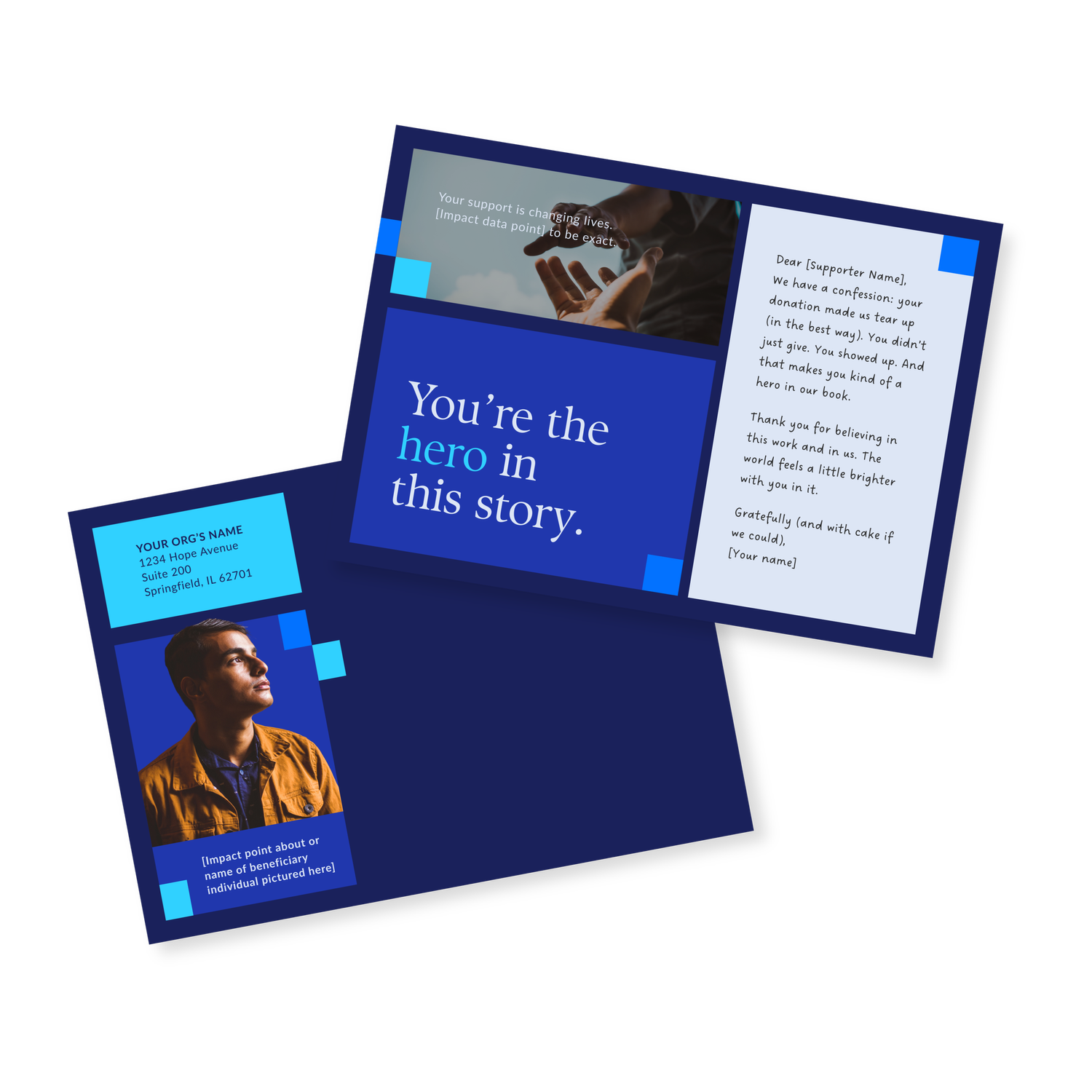Design feedback is one of the fastest ways to either build belief… or accidentally flatten the soul of your story.
You’ve seen it happen.
A beautiful piece gets passed around for “quick thoughts,” and suddenly:
– The headline gets safer.
– The layout gets busier.
– The mission gets quieter.
By round three, the design feels more like a committee compromise than a reflection of your organization’s heartbeat. And nobody meant for that to happen. It’s just the reality of a well-meaning, very human feedback process.
You can fix this. Start with feedback that honors your mission and gives your designer the direction they need to make your impact felt.
Why Design Feedback Gets Messy (Especially in Nonprofits)
Nonprofits live at the intersection of urgency, collaboration, and incredible heart. Creating content is only part of your job. You’re also stewarding stories, protecting relationships, and making sure every piece reflects who you are.
That’s a lot of responsibility.
And it creates predictable friction:
1. Everyone feels responsible for accuracy.
Program teams care deeply about the work being told correctly. Development is focused on donor comprehension and conversion. Leadership cares about reputation. None of that is wrong. It’s simply a lot for one design to hold.
2. People jump to solutions instead of articulating the real issue.
“Make it bigger” is easy to say.
But “I’m losing the main message” is more useful.
Designers already know how to solve visual problems. What they need from you is the meaning behind the message.
3. Personal preference sneaks in disguised as direction.
You love teal. But your donors might read teal as “youth program” when your mission is workforce development.
Great design is guided by what earns trust from your audience, not by internal style preferences.
4. Feedback arrives scattered and out of order.
Six Slack messages. Four Teams comments. One late-night email.
The designer ends up trying to resolve contradictions in your notes instead of focusing on thoughtful visual decisions.
And the work suffers for it.
What Helpful Design Feedback Actually Sounds Like
Think of design feedback the same way you think about donor messaging: it should be clear, grounded in purpose, and emotionally intelligent.
Here’s what that looks like in practice:
1. Start with the purpose, not the pixels.
Your designer needs to know what this piece is supposed to build belief in.
Try: “Someone reading this for the first time should immediately feel we’re serious about long-term impact.”
This gives your designer a North Star.
2. Name the tension you’re feeling, not the fix you want.
- “I’m getting lost here.”
- “This feels heavier than our usual voice.”
- “I’m not sure the key message is connecting easily.”
These notes give your designer meaningful direction while preserving their creative problem-solving power.
3. Use your donor as the lens for every comment.
Your team understands the nuance. Your donors don’t, and they shouldn’t have to.
Try: “If a brand-new donor saw this, would they understand the win?”
Audience-focused feedback helps you see whether someone new can understand the piece instantly.
4. Consolidate before you communicate.
One voice. One list. One decision-maker.
This one shift can speed up your timeline and keep your designer from sorting through mixed messages.
A Simple, Nonprofit-Friendly Framework for Better Design Feedback
If you want a smoother process that protects your time and your mission, use this structure:
Step 1: Re-align on the purpose of the piece
Before anyone dives into colors or copy, pause and remind yourselves why this piece exists.
- Who is it for?
- What should they feel when they see it?
- What action or belief should it strengthen?
Design is mission translation, and the goal has to lead the process.
Step 2: Review the design in the context it was meant for
Look at the work where it actually lives.
- A social graphic should be reviewed on a phone.
- A deck should be viewed on a conference screen.
- A report should be printed, held, and experienced as a physical piece.
Context shapes comprehension, so give the design a fair evaluation in its real environment.
Step 3: Start by naming what’s working
Point out the sections that feel aligned, the tone that feels right, or the layout that supports the story.
- “This section feels like us.”
- “This tone is exactly right.”
- “This layout makes the message easy to follow.”
When a designer knows what’s staying, they can make stronger decisions without worrying about undoing elements the team already approved.
Step 4: Share what’s not connecting and why
Focus on what’s creating friction, whether it’s hierarchy, tone, focus, or emotion.
- “This stat feels buried.”
- “The CTA isn’t visible enough.”
- “This feels more corporate than community-centered.”
Specific observations help the whole team stay aligned on what actually needs to shift.
Step 5: Give the designer space to solve the problem
Once you’ve articulated the issue, step back and let the designer explore solutions that honor both your mission and your audience. That’s where thoughtful, belief-building design decisions come to life.
The Most Common Feedback Pitfalls (and What to Do Instead)
These are the exact places where belief-building design starts to erode.
And they’re all fixable.
Pitfall 1: Editing instead of evaluating
Don’t rewrite the design. Help the designer understand the feeling you need to convey.
Pitfall 2: Dropping feedback in multiple places
This turns into a game of “Which comment wins?”
Try: One channel for all notes. One final voice.
Here at Acton Circle, we have a streamlined annual report process to get all your feedback in one place so you don't have to worry about it!
Pitfall 3: Introducing new ideas late
If the goal changed, say that directly. If the preference changed, decide if it’s worth restarting.
Pitfall 4: Making decisions based on personal taste
Design taste is natural. But your community makes decisions based on what they understand and feel, not on the internal preferences of your team.
Pitfall 5: Assuming faster is better
Design is a form of interpretation, and it needs time to develop.
Give your designer room to think, and you’ll receive work worth believing in.
How Small Teams Can Give Better Feedback Without More Meetings
You don’t need more tools or another system. What helps is a simple, predictable way for feedback to move from your team to your designer.
Small teams can stay on track when feedback is centralized and moves in one direction instead of coming from everywhere at once. Here's how to do this:
1. Keep feedback rounds time-bound
Give your team 1–2 days to review. Parkinson’s Law always shows up here—if people have a week, they’ll take a week. Short windows keep the project moving.
2. Store everything in one place
Choose one doc or one email thread and stick to it. Designers work faster when all feedback lives in a single, organized home.
3. Use a shared “review lens” checklist
- Is the message clear?
- Does this feel like us?
- Would a new donor understand it instantly?
- Is the emotional tone right?
- Is the CTA visible and unmistakable?
5 Ways to Make Your Design Feedback More Effective
1. Lead with the outcome
Tell the designer the belief or feeling you want to strengthen.
2. Match your feedback to the stage
Concept rounds = direction.
Near-final rounds = precision.
3. Ask before assuming
A quick “What was your intention here?” removes so much confusion.
4. Prioritize the top three changes
Clear priorities prevent unnecessary rounds and help your designer concentrate on the changes with the biggest impact.
5. Trust your designer’s craft
You know the mission, the nuance, and the emotional core. Your designer can bring that to life once you give them the context they need, not by solving it for them, but by helping them see the “why.”
Frequently Asked Questions About Giving Design Feedback
How do I give design feedback without hurting the relationship?
Be honest about what isn’t working, but always start with what is working. Designers need direction and they thrive when they understand the purpose behind your note.
Clear observations (“I’m losing the main message here”) come across better than personal preferences (“I don’t like this color”). Feedback builds trust when it’s rooted in shared goals.
What’s the difference between helpful feedback and micromanaging?
Helpful feedback names the problem.
Micromanaging dictates the solution.
Instead of telling the designer what to change, describe why something feels off. When you articulate the tension (“This feels too corporate for our community-centered mission”), your designer can solve it in a way that elevates your story.
How many people should be involved in the feedback process?
Ideally, one decision-maker and one feedback channel.
Nonprofits often have many voices, but too many reviewers creates conflicting notes and slows the project. Consolidating feedback honors everyone’s perspective and protects the integrity of your design.
For most of our clients, the project lead is the one empowered to make the final call. It’s worth confirming this with leadership before the project starts.
What should I look for when reviewing a design draft?
Review it through the eyes of the person it’s meant to reach—a donor, a partner, a community member, or someone brand new to your work. Look for whether the message is easy to understand, whether the hierarchy guides their eye, and whether the tone and emotion match the audience.
If you’re unsure, start with one question: “What’s the single takeaway we want them to leave with?”
How do I give feedback when I don’t know design terms?
You don’t need design vocabulary.
Try using phrases like:
- “I’m having trouble finding the key message.”
- “This part feels too busy.”
- “This doesn’t feel like our usual tone.”
When is it too late to make major changes to a design?
Big directional shifts should happen earlyl, during concepts or the first draft.
By the near-final stage, feedback should focus on polish, not reworking the entire hierarchy or message. If you introduce a new strategic goal late in the process, expect timeline and scope changes.
How can nonprofits speed up the design feedback process?
Use one feedback channel, timebox your reviews (24–48 hours), and consolidate notes before they reach the designer. A simple internal checklist for clarity, tone, donor understanding, hierarchy, helps teams get aligned fast and avoid unnecessary revisions.
Why does my designer ask about the goal instead of just making revisions?
Your designer may not just be a task-taker. Their job is to translate your mission into visuals your donors can connect with. Allow them to bring ideas and their fresh perspective to the table.
Should board members give design feedback?
Boards can offer valuable perspective, but they shouldn’t drive creative direction unless the piece is specifically for them or they have special insights.
Keep board input high-level and rooted in mission, not personal preference. Remember, your design should reflect donor psychology, not a committee’s taste.
What if my team can’t agree on feedback?
Return to the purpose of the piece.
Ask:
- Who is this for?
- What should they feel and understand?
- What’s the main action or belief we need to strengthen?
Keeping Your Mission at the Center of All Design Feedback
When you center your audience, speak with one voice, and articulate the why behind your reactions, the design doesn’t just get better… it gets truer. It becomes the kind of visual storytelling that makes donors feel your impact before they even read a word.
And that’s where belief begins.
If you’d rather partner with a team that’s already expert in managing feedback and shaping the story, our Annual Report Design Intensives make the process simple and confidence-building from day one.

Donor Thank You Cards
Download the free pack to get 4 postcard designs (7x5in) with editable messages.











